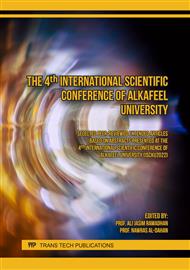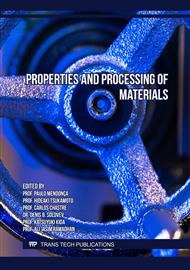[1]
P. Singh, K. M. K. Srivatsa, and S. Das, "Effect of substrate temperature on nanocrystalline CeO2 thin films deposited on Si substrate by RF magnetron sputtering," Adv. Mater. Lett., vol. 6, no. 5, p.371–376, 2015.
DOI: 10.5185/amlett.2015.5777
Google Scholar
[2]
Y. Liu et al., "Electrospun CeO2 nanoparticles/PVP nanofibers based high-frequency surface acoustic wave humidity sensor," Sensors Actuators, B Chem., vol. 223, p.730–737, 2016.
DOI: 10.1016/j.snb.2015.09.148
Google Scholar
[3]
F. Dvořák et al., "Adjusting morphology and surface reduction of CeO2(111) thin films on Cu(111)," J. Phys. Chem. C, vol. 115, no. 15, p.7496–7503, 2011.
DOI: 10.1021/jp1121646
Google Scholar
[4]
H. A. Gatea, "Effect of High Temperature on Thermal Analysis, Structure and Morphology of CeO2 Nanoparticles Prepared by Hydrothermal Method," Int. J. Thin Film Sci. Technol., vol. 11, no. 2, p.201–206, 2022.
DOI: 10.18576/ijtfst/110207
Google Scholar
[5]
B. Bayyappagari, K. Shaik, M. R. Nasina, O. Inturu, and S. R. Dugasani, "Effect of Fe substitution on optical and magnetic properties of CeO2 nanoparticles," Optik (Stuttg)., vol. 154, p.821–827, 2018.
DOI: 10.1016/j.ijleo.2017.10.025
Google Scholar
[6]
H. A. Gatea, H. Abbas, and I. S. Naaji, "Effect of Sr+ ion Concentration on Microstructure and Dielectric properties of Barium Strontium Titanate Ceramics," Int. J. Thin Film Sci. Technol., vol. 11, no. 2, p.239–244, 2022.
DOI: 10.18576/ijtfst/110212
Google Scholar
[7]
I. S. Naji and H. A. Gatea, "Influence of sintering temperature on ferroelectric ba0.7sr0.3tio3 microstructure, grain size, and electrical properties," Int. J. Thin Film Sci. Technol., vol. 9, no. 2, p.133–141, 2020.
DOI: 10.18576/ijtfst/090207
Google Scholar
[8]
H. A. Gatea, "Impact of Annealing Temperature on Optical Properties of CeO2 Thin Films Deposition by Spin Coating Technique," no. 220, p.2–4, 2022.
DOI: 10.1109/hora55278.2022.9799831
Google Scholar
[9]
X. Z. Song, W. Y. Zhu, X. F. Wang, and Z. Tan, "Recent Advances of CeO2-Based Electrocatalysts for Oxygen and Hydrogen Evolution as well as Nitrogen Reduction," ChemElectroChem, vol. 8, no. 6, p.996–1020, 2021.
DOI: 10.1002/celc.202001614
Google Scholar
[10]
S. Phokha et al., "Effect of annealing temperature on the structural and magnetic properties of CeO2 thin films," Thin Solid Films, vol. 704, no. March, p.138001, 2020.
DOI: 10.1016/j.tsf.2020.138001
Google Scholar
[11]
S. R. Ali, R. Kumar, A. Kalam, A. G. Al-Sehemi, and M. C. Arya, "Effect of Strontium Doping on the Band Gap of CeO 2 Nanoparticles Synthesized Using Facile Co-precipitation," Arab. J. Sci. Eng., vol. 44, no. 7, p.6295–6302, 2019.
DOI: 10.1007/s13369-018-03700-x
Google Scholar
[12]
P. Mele, T. Endo, S. Arisawa, C. Li, and T. Tsuchiya, Oxide thin films, multilayers, and nanocomposites. 2015.
DOI: 10.1007/978-3-319-14478-8
Google Scholar
[13]
R. H. R. C. Benthem, Klaus Van, A. Lakshmanan, W. E. Lee, and Suk-Joong L.Kang, SINTERING OF CERAMICS – NEW EMERGING Edited by Arunachalam Lakshmanan, vol. 35, no. 1. 2005.
Google Scholar
[14]
G. Balakrishnan et al., "Microstructure, optical and dielectric properties of cerium oxide thin films prepared by pulsed laser deposition," J. Mater. Sci. Mater. Electron., vol. 30, no. 17, p.16548–16553, 2019.
DOI: 10.1007/s10854-019-02031-3
Google Scholar
[15]
M. L. Lavčević, A. Turković, P. Dubček, and S. Bernstorff, "Nanostructured CeO2 thin films: A SAXS study of the interface between grains and pores," Thin Solid Films, vol. 515, no. 14 SPEC. ISS., p.5624–5626, 2007.
DOI: 10.1016/j.tsf.2006.12.014
Google Scholar
[16]
T. An, X. Deng, S. Liu, S. Wang, J. Ju, and C. Dou, "Growth and roughness dependent wetting properties of CeO2 films prepared by glancing angle deposition," Ceram. Int., vol. 44, no. 8, p.9742–9745, 2018.
DOI: 10.1016/j.ceramint.2018.02.206
Google Scholar
[17]
N. I. Santha et al., "Effect of doping on the dielectric properties of cerium oxide in the microwave and far-infrared frequency range," J. Am. Ceram. Soc., vol. 87, no. 7, p.1233–1237, 2004.
DOI: 10.1111/j.1151-2916.2004.tb07717_33.x
Google Scholar
[18]
W. Qin, L. Xu, J. Song, R. Xing, and H. Song, "Highly enhanced gas sensing properties of porous SnO2-CeO 2 composite nanofibers prepared by electrospinning," Sensors Actuators, B Chem., vol. 185, p.231–237, 2013.
DOI: 10.1016/j.snb.2013.05.001
Google Scholar



